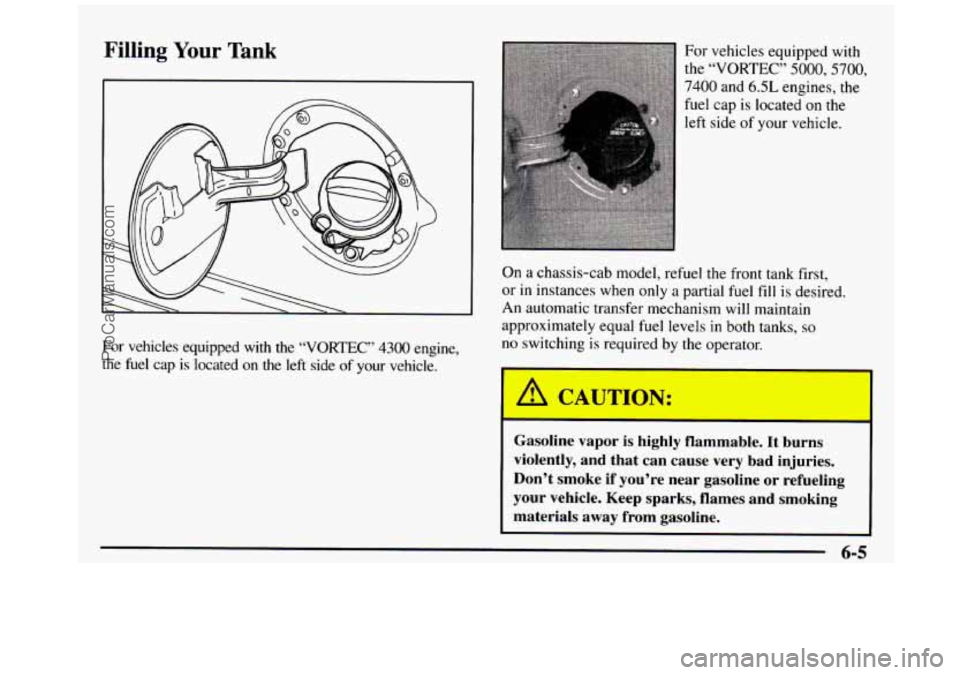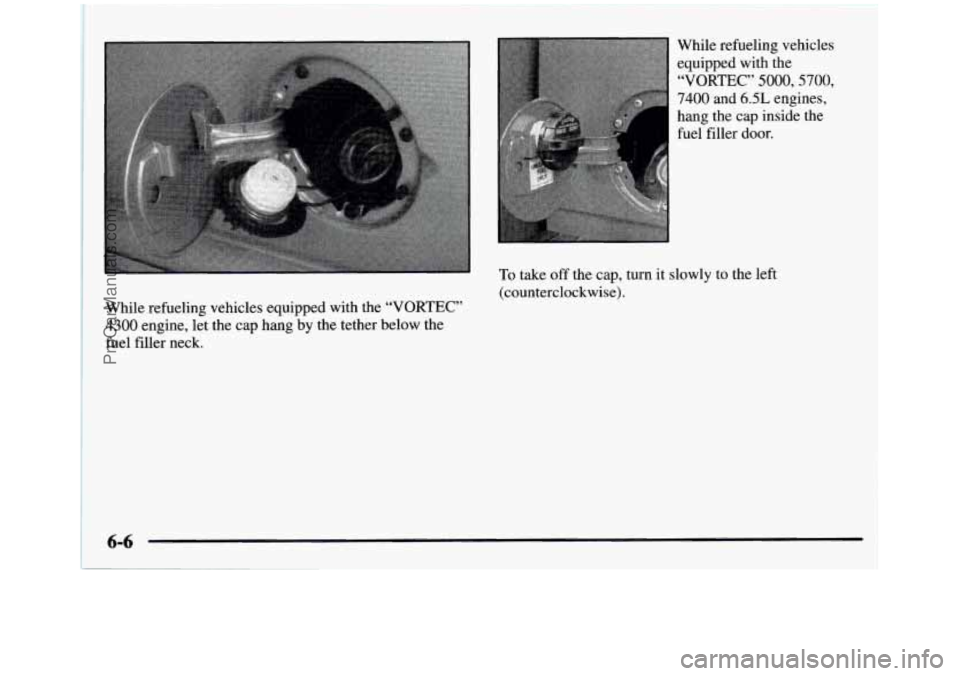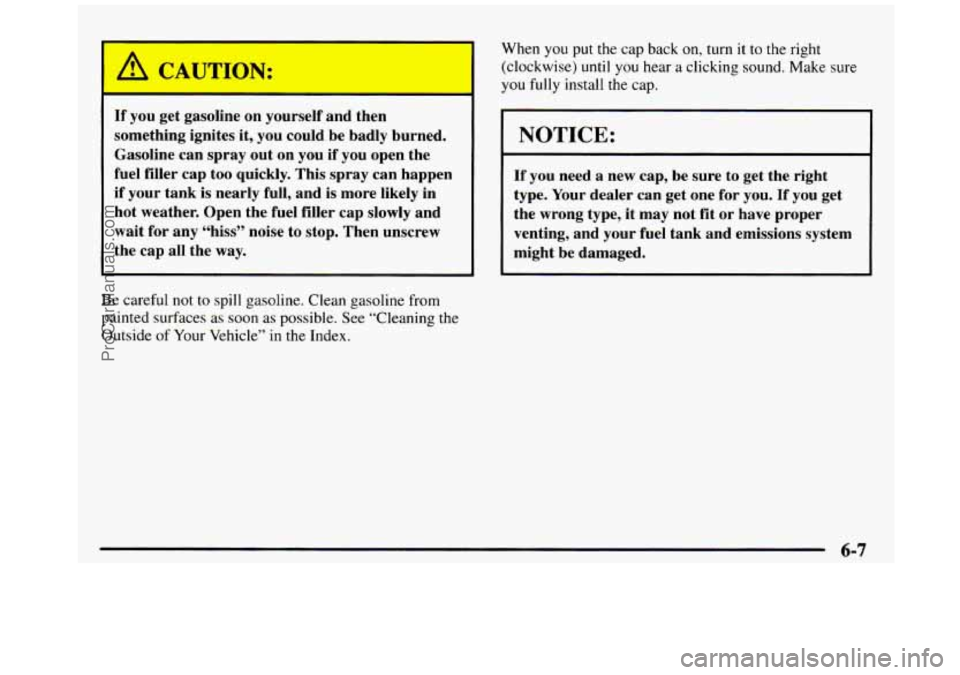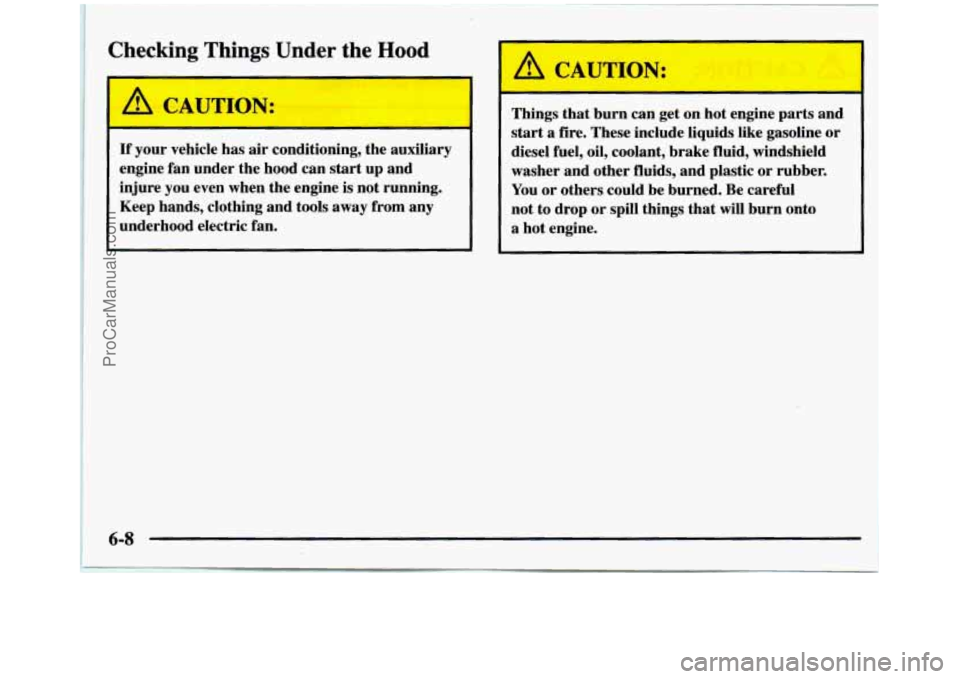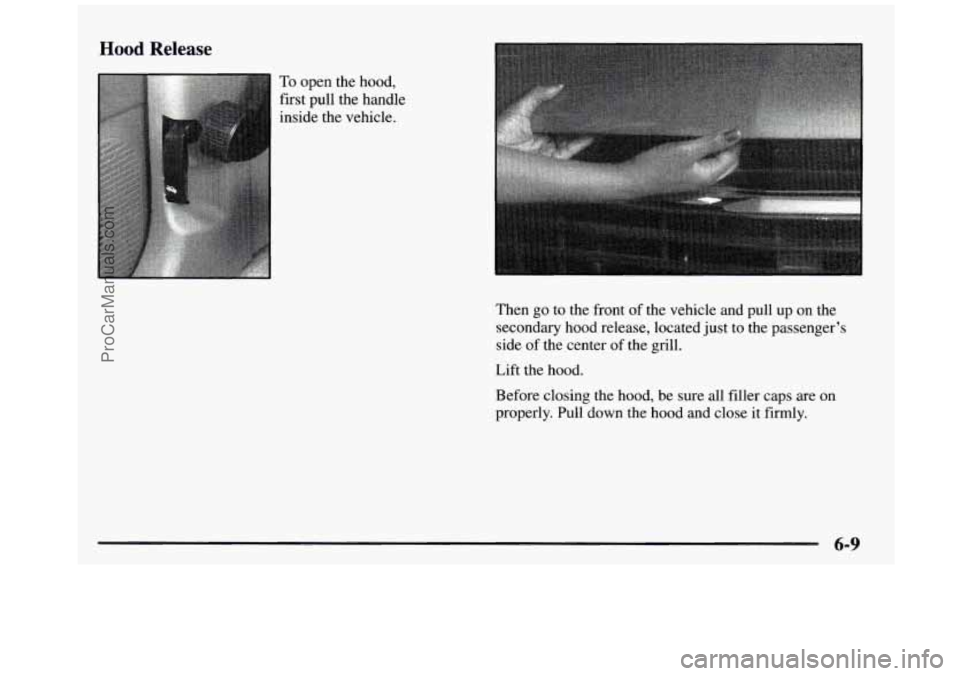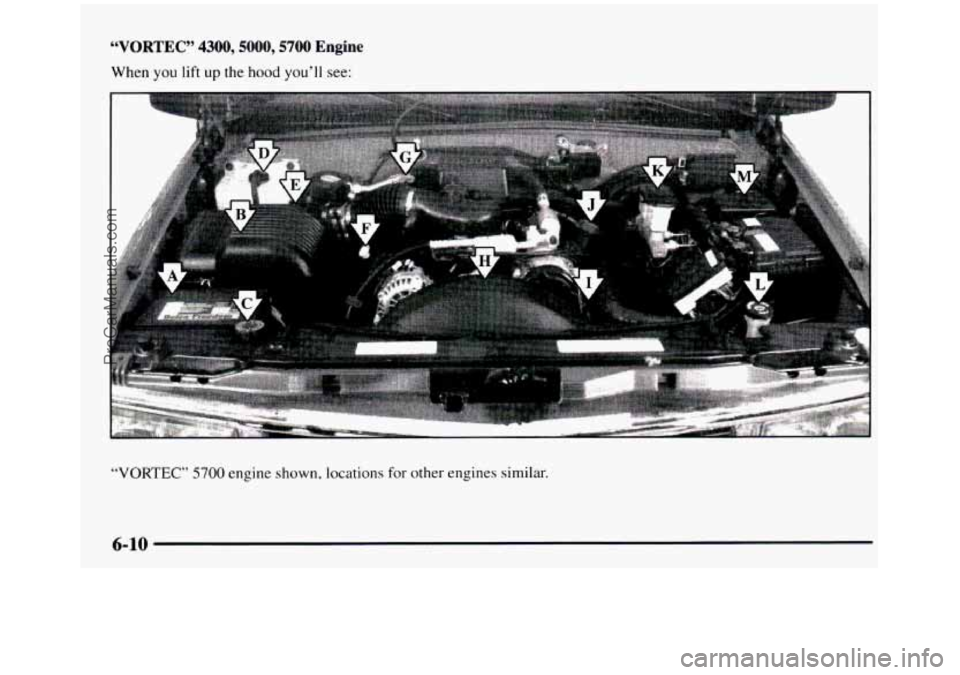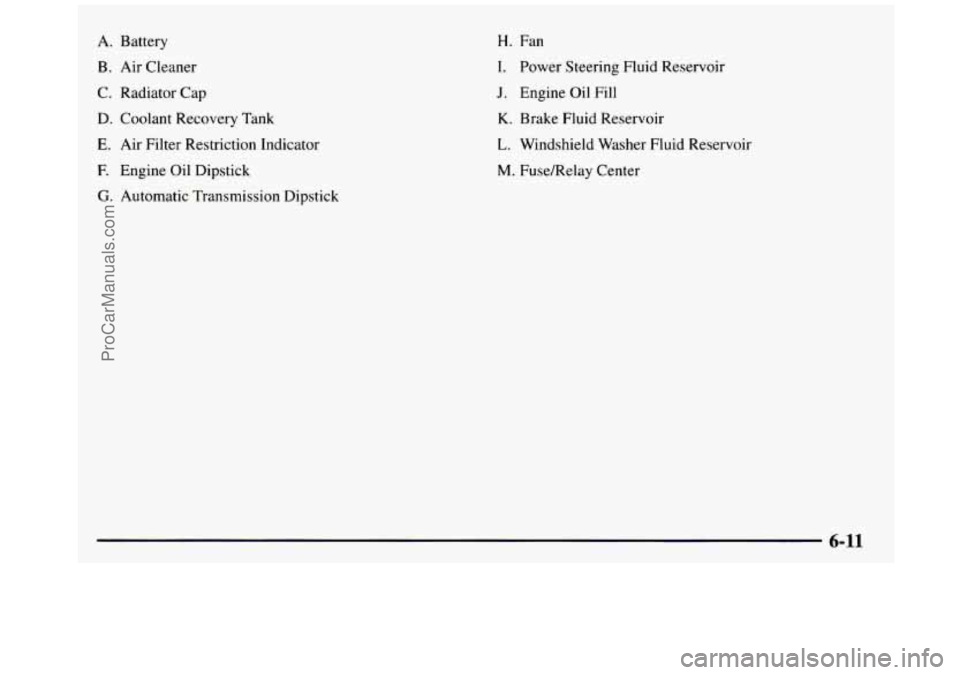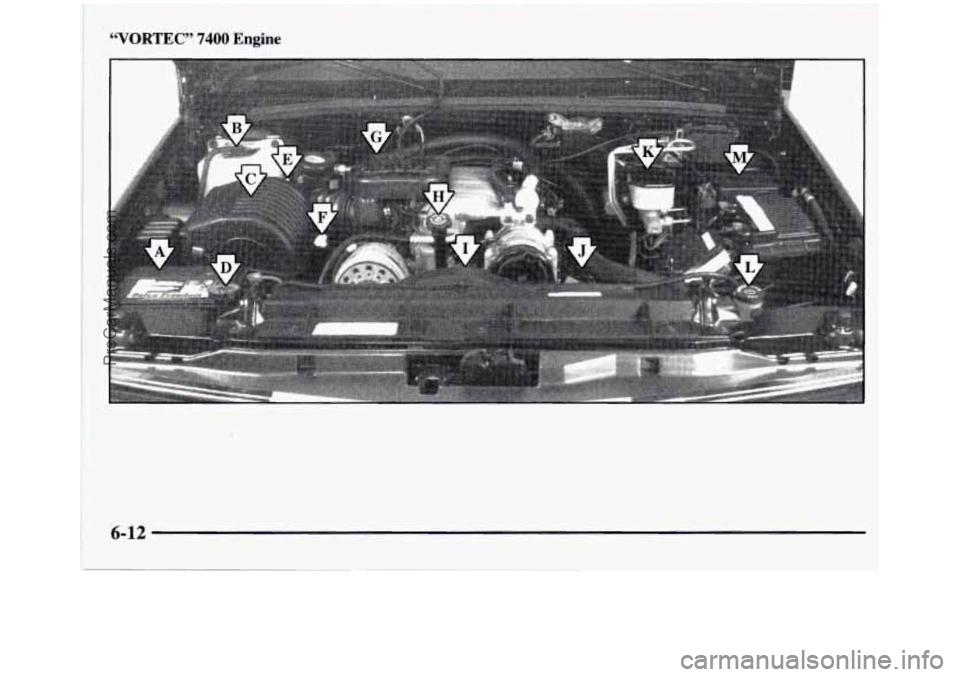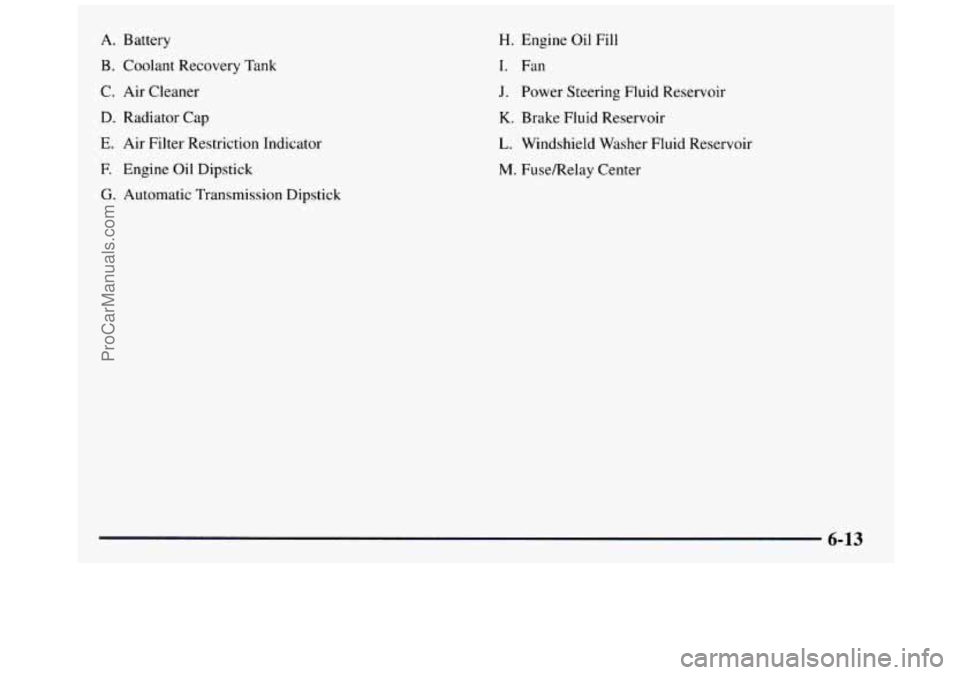GMC SIERRA 1997 Owners Manual
Manufacturer: GMC, Model Year: 1997,
Model line: SIERRA,
Model: GMC SIERRA 1997
Pages: 436, PDF Size: 23.38 MB
GMC SIERRA 1997 Owners Manual
SIERRA 1997
GMC
GMC
https://www.carmanualsonline.info/img/44/57863/w960_57863-0.png
GMC SIERRA 1997 Owners Manual
Trending: start stop button, AUX, fuel tank capacity, fuel additives, ignition, USB, engine oil capacity
Page 281 of 436
Filling Your Tank
For vehicles equipped with the “VORTEC” 4300 engine,
the
fuel cap is located on the left side of your vehicle. For vehicles equipped with
the “VORTEC” 5000,5700,
7400 and 6.5L engines, the
fuel cap
is located on the
left side
of your vehicle.
On a chassis-cab model, refuel the front tank first,
or in instances when
only a partial fuel fill is desired.
An automatic transfer mechanism will maintain
approximately equal fuel levels in both tanks,
so
no switching is required by the operator.
.- i
‘P ’ION:
Gasoline vapor is highly flammable. It burns
violently, and that can cause very bad injuries.
Don’t smoke if you’re near gasoline or refueling
your vehicle.
Keep sparks, flames and smoking
materials away from gasoline.
6-5
ProCarManuals.com
Page 282 of 436
7400 and 6.5L engines,
hang the cap inside the fuel filler door.
To take off the cap, turn it slowly to the left
(counterclockwise).
While refueling vehicles equipped with the
“VORTEC”
4300 engine, let the cap hang by the tether below the
fuel filler neck.
6-6
ProCarManuals.com
Page 283 of 436
/1 CAUTION:
If you get gasoline on yourself and then
something ignites it, you could be badly burned. Gasoline can spray out on you if you open the
fuel filler cap too quickly. This spray can happen
if your tank is nearly full, and
is more likely in
hot weather. Open the fuel filler cap slowly and
wait for
any “hiss” noise to stop. Then unscrew
the cap all the
way.
When you put the cap back on, turn it to the right
(clockwise)
until you hear a clicking sound. Make sure
you fully install the cap.
NOTICE:
If you need a new cap, be sure to get the right
type.
Your dealer can get one for you. If you get
the wrong type, it may not
fit or have proper
venting, and your fuel tank and emissions system
might be damaged.
Be careful not
to spill gasoline. Clean gasoline from
painted surfaces as soon as possible. See “Cleaning the
Outside of Your Vehicle” in the Index.
6-7
ProCarManuals.com
Page 284 of 436
Checking Things Under the Hood
I A CAUTION:
If your vehicle has air conditioning, the auxiliary
engine fan under the hood can
start up and
injure you even when the engine
is not running.
Keep hands, clothing and tools away from any
underhood electric
fan.
t -4
Things that burn can get on hot engine parts and
start a fire. These include liquids like gasoline or
diesel fuel, oil, coolant, brake fluid, windshield
washer and other fluids, and plastic or rubber. You or others could be burned. Be careful
not to drop or spill things that will burn onto
a hot engine.
ProCarManuals.com
Page 285 of 436
Hood Release
To open the hood,
first pull the handle
inside the vehicle.
Then
go to the front of the vehicle and pull up on the
secondary hood release, located just to the passenger’s
side of the center
of the grill.
Lift the hood.
Before closing the hood, be sure all filler caps are on
properly. Pull down the hood and close it firmly.
6-9
ProCarManuals.com
Page 286 of 436
“VORTEC” 4300,5000,5700 Engine
When you lift up the hood you’ll see:
“VORTEC” 5700 engine shown, locations for other engines similar.
6-10
ProCarManuals.com
Page 287 of 436
A. Battery
B. Air Cleaner
C. Radiator Cap
D. Coolant Recovery Tank
E. Air Filter Restriction Indicator
F. Engine Oil Dipstick
G. Automatic Transmission Dipstick
H. Fan
I. Power Steering Fluid Reservoir
J. Engine Oil Fill
K. Brake Fluid Reservoir
L. Windshield Washer Fluid Reservoir
M. Fuse/Relay Center
6-11
ProCarManuals.com
Page 288 of 436
3
B
6-12
I
ProCarManuals.com
Page 289 of 436
A. Battery
B. Coolant Recovery Tank
C. Air Cleaner
D. Radiator Cap
E. Air Filter Restriction Indicator
E Engine Oil Dipstick
G. Automatic Transmission Dipstick
H. Engine Oil Fill
I. Fan
J. Power Steering Fluid Reservoir
K. Brake Fluid Reservoir
L. Windshield Washer Fluid Reservoir
M. FuseRelay Center
6-13
ProCarManuals.com
Page 290 of 436
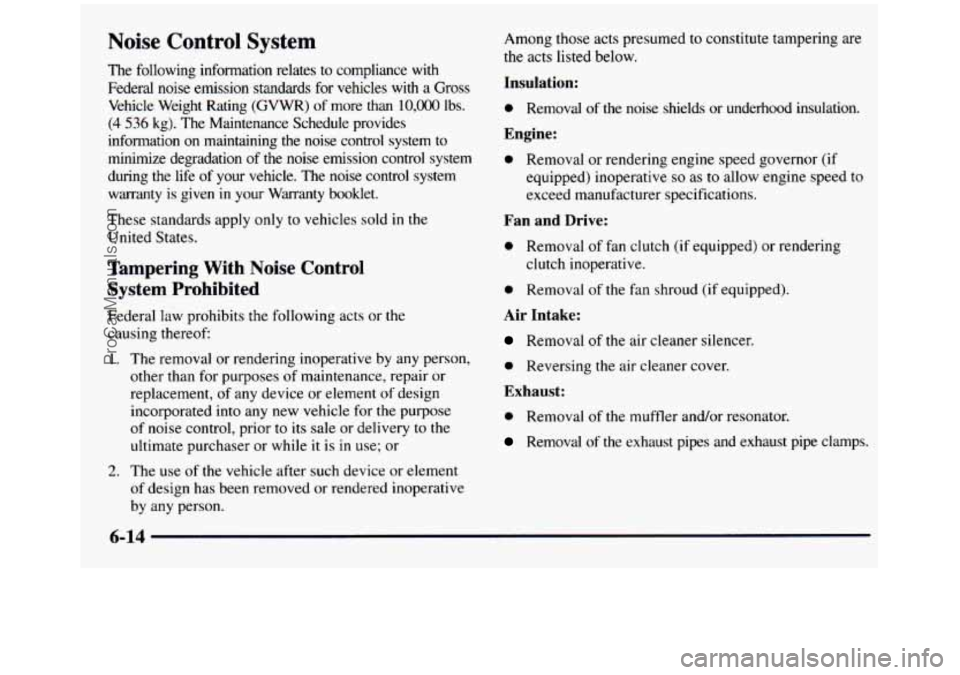
Noise Control System
The following information relates to compliance with Federal noise emission standards
for vehicles with a Gross
Vehicle Weight Rating (GVWR) of more than
10,OOO lbs.
(4 536 kg). The Maintenance Schedule provides
information
on maintaining the noise control system to
minimize degradation of the noise emission control system
during the life of your vehicle. The noise control system
warranty is given in your Warranty booklet.
These standards apply only to vehicles sold
in the
United States.
Tampering With Noise Control
System Prohibited
Federal law prohibits the following acts or the
causing thereof:
I. The removal or rendering inoperative by any person,
other than for purposes of maintenance, repair or
replacement,
of any device or element of design
incorporated into any new vehicle for
the purpose
of noise control, prior to its sale or delivery
to the
ultimate purchaser or while it is in use; or
2. The use of the vehicle after such device or element
of design has
been removed or rendered inoperative
by any person. Among those
acts presumed
to constitute tampering are
the acts listed below.
Insulation:
0 Removal of the noise shields or underhood insulation.
Engine:
0 Removal or rendering engine speed governor (if
equipped) inoperative
so as to allow engine speed to
exceed manufacturer specifications.
Fan and Drive:
0 Removal of fan clutch (if equipped) or rendering
clutch inoperative.
0 Removal of the fan shroud (if equipped).
Air Intake:
Removal of the air cleaner silencer.
0 Reversing the air cleaner cover.
Exhaust:
0 Removal of the muffler and/or resonator.
Removal of the exhaust pipes and exhaust pipe clamps.
ProCarManuals.com
Trending: airbag off, oil temperature, battery, wipers, charging, overheating, manual transmission
